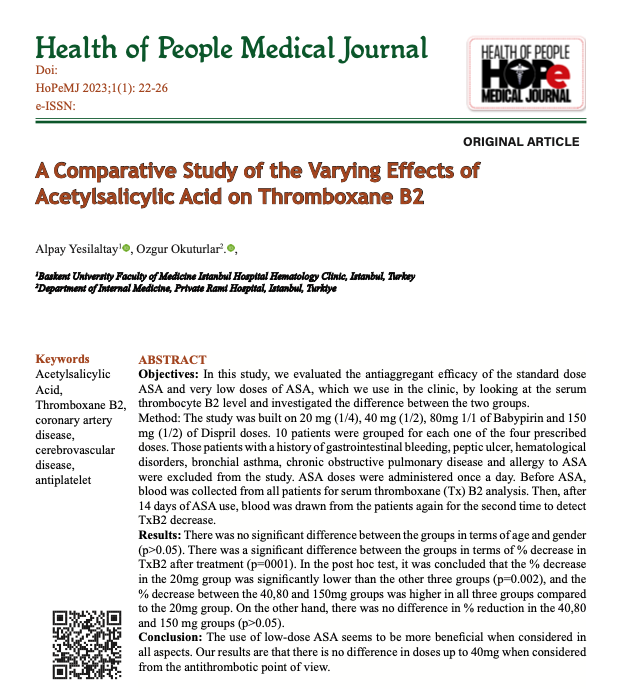A Comparative Study of the Varying Effects of Acetylsalicylic Acid on Thromboxane B2
Keywords:
Acetylsalicylic Acid, Thromboxane B2, coronary artery disease, cerebrovascular disease, antiplateletAbstract
Objective: In this study, we evaluated the antiaggregant efficacy of the standard dose ASA and very low doses of ASA, which we use in the clinic, by looking at the serum thrombocyte B2 level and investigated the difference between the two groups.
Method: The study was built on 20 mg (1/4), 40 mg (1/2), 80mg 1/1 of Babypirin and 150 mg (1/2) of Dispril doses. 10 patients were grouped for each one of the four prescribed doses.
Those patients with a history of gastrointestinal bleeding, peptic ulcer, hematological disorders, bronchial asthma, chronic obstructive pulmonary disease and allergy to ASA were excluded from the study . ASA doses were administered once a day.
Before ASA, blood was collected from all patients for serum thromboxane (Tx) B2 analysis. Then, after 14 days of ASA use, blood was drawn from the patients again for the second time to detect TxB2 decrease.
Results: There was no significant difference between the groups in terms of age and gender (p>0.05). There was a significant difference between the groups in terms of % decrease in TxB2 after treatment (p=0001). In the post hoc test, it was concluded that the % decrease in the 20mg group was significantly lower than the other three groups (p=0.002), and the % decrease between the 40,80 and 150mg groups was higher in all three groups compared to the 20mg group. On the other hand, there was no difference in % reduction in the 40,80 and 150 mg groups (p>0.05).
Conclusion: The use of low-dose ASA seems to be more beneficial when considered in all aspects. Our results are that there is no difference in doses up to 40mg when considered from the antithrombolytic point of view.
References
Collaboration AT. Collaborative overview of randomized trials of antiplatelet therapy Prevention of death, myocardial infarction, and stroke by prolonged antiplatelet therapy in various categories of patients. Bmj. 1994;308(6921):81-106.
Lansberg MG, O'Donnell MJ, Khatri P, Lang ES, Nguyen-Huynh MN, Schwartz NE, et al. Antithrombotic and thrombolytic therapy for ischemic stroke: Antithrombotic Therapy and Prevention of Thrombosis, 9th ed: American College of Chest Physicians Evidence-Based Clinical Practice Guidelines. Chest. 2012;141(2 Suppl):e601S-e36S.
Kleindorfer DO, Towfighi A, Chaturvedi S, Cockroft KM, Gutierrez J, Lombardi-Hill D, et al. 2021 Guideline for the Prevention of Stroke in Patients With Stroke and Transient Ischemic Attack: A Guideline From the American Heart Association/American Stroke Association. Stroke. 2021;52(7):e364-e467.
Collaborative meta-analysis of randomized trials of antiplatelet therapy for prevention of death, myocardial infarction, and stroke in high risk patients. Bmj. 2002;324(7329):71-86.
Schror K. Aspirin and platelets: The antiplatelet action of aspirin and its role in thrombosis treatment and prophylaxis. Seminars in Thrombosis and Hemostasis. 1997;23(4):349-56.
Spitz B, Vanbree R, Vanballaer P, Verbeke G, Hanssens M, Vanassche F. Dıfferentıal Inhıbıtıon Of Vascular Prostacyclın And Platelet Thromboxane Synthesıs By Dıfferent Doses Aspırın And By The Thromboxane Inhıbıtor Rıdogrel (R-68070). Clinical and Experimental Hypertension Part B-Hypertension in Pregnancy. 1991;10(3):371-83.
Adamek T, Paluch Z, Alusik S. Difficulties of Thromboxane Production Measurement in Clinical Practice. Chemicke Listy. 2019;113(5):315-9.
Weksler BB, Pett SB, Alonso D, Richter RC, Stelzer P, Subramanian V, et al. Differential inhibition by aspirin of vascular and platelet prostaglandin synthesis in atherosclerotic patients. New England Journal of Medicine. 1983;308(14):800-5.
Malhotra S, Sharma Y, Grover A, Majumdar S, Hanif S, Bhargava V, et al. Effect of different aspirin doses on platelet aggregation in patients with stable coronary artery disease. Internal medicine journal. 2003;33(8):350-4.
Preston FE, Whipps S, Jackson CA, French AJ, Wyld PJ, Stoddard CJ. Inhibition of prostacyclin and platelet thromboxane A2 after low-dose aspirin. N Engl J Med. 1981;304(2):76-9.
Parker WAE, Orme RC, Hanson J, Stokes HM, Bridge CM, Shaw PA, et al. Very-low-dose twice-daily aspirin maintains platelet inhibition and improves haemostasis during dual-antiplatelet therapy for acute coronary syndrome. Platelets. 2019;30(2):148-57.
Kocoglu H, Oguz B, Dogan H, Okuturlar Y, Hursitoglu M, Harmankaya O, et al. Do NSAIDs and ASA cause more upper gastrointestinal bleeding in elderly than adults? Gastroenterology Research and Practice. 2016;2016.
Huang WY, Saver JL, Wu YL, Lin CJ, Lee M, Ovbiagele B. Frequency of Intracranial Hemorrhage With Low-Dose Aspirin in Individuals Without Symptomatic Cardiovascular Disease: A Systematic Review and Meta-analysis. JAMA Neurol. 2019;76(8):906-14.

Downloads
Published
How to Cite
Issue
Section
License
Copyright (c) 2023 Health of People Medical Journal

This work is licensed under a Creative Commons Attribution-NonCommercial-NoDerivatives 4.0 International License.
The Editorial Board of the Health of People Medical Journal complies with the criteria of the International Council of Medical Journal Editors (ICMJE), the World Association of Medical Editors (WAME), and the Committee on Publication Ethics (COPE).
1. All editorial members, reviewers, and authors must confirm and obey the rules defined by COPE.
2. The corresponding author is the main owner of the article, so she/he can withdraw the article when it is incomplete (before entering the review process or when a revision is asked for).
3. Authors cannot make major changes in the article after acceptance without a serious reason.
4. All editorial members and authors must will to publish any corrections honestly and completely.
5. Any notes of plagiarism, fraudulent data, or other kinds of fraud must be reported completely to COPE.




